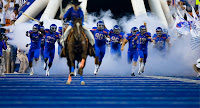
Several years ago I consulted with a company in The Netherlands on a city government project to enable all city workers to instantly become the eyes and ears of the police during emergencies. It worked like this - an alert would be sent to all city workers that had government issued phones and were located in a certain geographic area. This alert would ask them to look for a specific car, person or suspicious activity.
This project was clever, efficient but also a little creepy. If the police are chasing a bad guy through the city, then asking for all city workers within a certain area to keep their eyes and ears open is efficient, since it is in all of our best interests to stop bad guys, but in the wrong hands creepy. From a resource utilization, a great idea. This project was an early example of location based services (LBS). If your phone is in this particular zone, keep your eyes open for this bad guy.
This summer Microsoft acquired
EveryBlock, a company that feeds local crime and health inspection information to news organizations. With GPS enabled phones, crimes can be reported that are instantly shown on maps and available for the public to see. Instead of just using city employees you are turning the entire populace, at least those with
smartphones, into your eyes and ears.
Mobile technologies with integrated GPS are helping the public to be even more involved in the management and priorities of local government as this
NPR article describes. The
Citizens Connect iPhone app is part of the Boston Mayor's strategy for working closer with citizen's to help manage the city. The program is called Citizens Connect. The Citizens Connect iPhone app is targeted at enlisting Boston residents and visitors to gather information about the physical state of the city (See photo above about pothole reporting).
I am very impressed with these applications and their utility. I consulted on another project where a non-profit organization was taking inventory, using
smartphones, of trash and abandoned vehicles in particular neighborhoods. This information was then synchronized into a database and clean-up efforts were organized based upon this information.
Another interesting application that I read about yesterday is called Birdseye. This is an iPhone application for birdwatchers, but it is not just a static reference application. It uses the integrated GPS features of the iPhone to identify the location of bird sightings. This information gets uploaded to Cornell University's Lab of Ornithology and its massive
eBird database of bird sightings. This information is then distributed to all subscribed members of the
eBird email distribution list. Beware of reporting a rare bird in your backyard. In minutes you may have hundreds of strange people in safari attire and binoculars elbowing their way onto your property.
From a mobile technology standpoint, many of these iPhone applications are similar. They involve mobile data collection with integrated GPS coordinates that are uploaded to a
publicly available Internet based application that distributes this information to subscribed members and the collected data is shown on a map.
Have you seen other clever
applications? Please share them by adding them to the comments below.
***********************************************
Author Kevin Benedict
Independent Mobility Consultant, Wireless Industry Analyst and Marketing Consultant
www.linkedin.com/in/kevinbenedicthttp://kevinbenedict.ulitzer.com/http://mobileenterprisestrategies.blogspot.com/***********************************************



